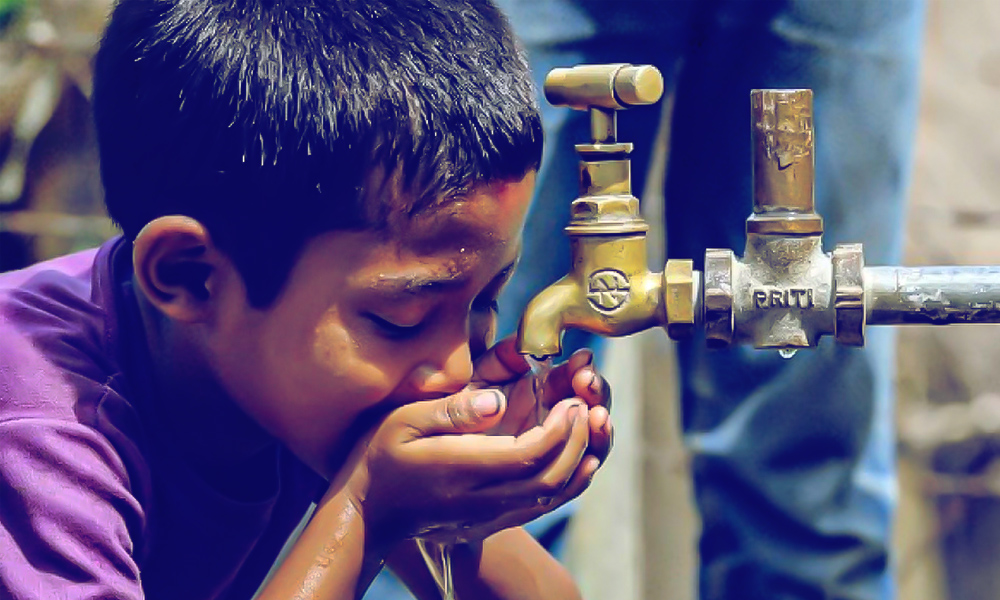
Image Credits: Zee News
Over 450 Million Children Globally Do Not Have Enough Water To Meet Their Everyday Needs: UNICEF
Writer: Palak Agrawal
Palak a journalism graduate believes in simplifying the complicated and writing about the extraordinary lives of ordinary people. She calls herself a " hodophile" or in layman words- a person who loves to travel.
Others/World, 19 March 2021 7:57 AM GMT
Editor : Prateek Gautam |
A free soul who believes that journalism, apart from politics, should stand for social cause and the environment.
Creatives : Rajath
A free spirit who find meaning in life with the virtue of creativity and doing job par its excellence, animal lover and traveller by heart.
In India, this threat looms over 20 million children.
Over 450 million children, globally, live in areas of high or extremely high water vulnerability, as per a recent study conducted by the United Nations International Children's Emergency Fund (UNICEF). Simply put, one in five children, across countries, does not have access to sufficient water to meet their everyday needs.
In India, this threat looms over 20 million children.
Water vulnerability is the degree to which access to water is subject to disruption. This could be due to various reasons including groundwater mining, low rainfall, polluted water bodies, population explosion, and climate change. Extreme water vulnerability refers to the factors of the highest levels of physical water scarcity risks and lowest levels of drinking water service affecting a given population.
The data collected has highlighted that children in more than 80 countries live in areas with high or extremely high water vulnerability.
"Eastern and Southern Africa has the highest proportion of children living in such areas, with more than half of children – 58 per cent – facing difficulty accessing sufficient water every day. It is followed by West and Central Africa (31 per cent), South Asia (25 per cent), and the Middle East (23 per cent). South Asia is home to the largest number of children living in areas of high or extremely high water vulnerability – more than 155 million children," it said.
The study is part of the 'Water Security for All' which identifies regions where physical water scarcity risks overlap with poor water service levels. It stated that communities living in these areas are dependent on surface water, unimproved sources of water which can take more than 30 minutes to collect.
Henrietta Fore, the Executive Director of UNICEF, said that climate change would make the water crisis worse.
"Children are the biggest victims. When wells dry-up, children are the ones missing school to fetch water. When droughts diminish food supplies, children suffer from malnutrition and stunting. When floods hit, children fall ill from waterborne illnesses. And when water resources decline, children cannot wash their hands to fight off diseases," Fore said.
"We can only achieve water security for every child through innovation, investment and collaboration, and by ensuring services are sustainable and resilient to climate shocks. For our children and our planet, we have to act," she further added.
37 countries including Afghanistan, Burkina Faso, Ethiopia, Haiti, Kenya, Nigeria, Pakistan, Papua New Guinea, Sudan, Tanzania and Yemen have been identified as 'hotspot' places where children face extremely dire circumstances in terms of absolute numbers, the proportions of children affected and where global resources, support and urgent action must be mobilised.
The study further pointed out that rapid population growth, urbanisation, misuse and mismanagement of available supplies, and extreme weather conditions have been putting pressure on the already dwindling water resources.
Yasmin Ali Haque, UNICEF India Representative, pointed out that water scarcity threatens the survival of affected families particularly women and children. Kids are exposed to waterborne diseases due to failure in adopting safe hygiene practices especially amid the COVID-19 pandemic, reported Business Standard.
"Women and girls are the most often burdened with fetching water long distances, which disrupts their education and opportunity for any work. This is exacerbated by the fact that India is particularly vulnerable to climate change, which exposes women and children to increasing environmental hazards.
"The COVID-19 pandemic has underscored the crucial need to establish access to clean water and sanitation, particularly for those living in the most vulnerable, water-scarce conditions," she said.
Climate disruptions are deteriorating the quality and quantity of water. Around 74 per cent of natural disasters between 2001 and 2018 were water-related, including droughts and floods, UNICEF said.
Rising temperatures can lead to the growth of deadly pathogens in freshwater sources thereby making the water unsuitable for consumption. Contaminated water poses a huge threat to children's lives. It is crucial to note that water and sanitation-related diseases are one of the leading causes of death in children under five years old.
Another study has suggested that by 2040, almost one in four children will live in areas of extremely high water stress.
 All section
All section














